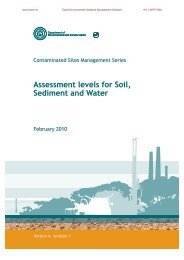EPA PUBLICATION 448 CLASSIFICATION OF WASTES - ESdat
EPA PUBLICATION 448 CLASSIFICATION OF WASTES - ESdat
EPA PUBLICATION 448 CLASSIFICATION OF WASTES - ESdat
You also want an ePaper? Increase the reach of your titles
YUMPU automatically turns print PDFs into web optimized ePapers that Google loves.
www.esdat.net Esdat Environmental Database Management Software +61 2 8875 7948<br />
<strong>EPA</strong> <strong>PUBLICATION</strong> <strong>448</strong> <strong>CLASSIFICATION</strong> <strong>OF</strong> <strong>WASTES</strong><br />
Table 1: Summary of waste types<br />
Category Description Management option<br />
Fill Material<br />
Solid Inert<br />
Putrescible<br />
Prescribed waste 3<br />
Category A<br />
Contaminated soil 4<br />
Category B<br />
Contaminated soil 4<br />
Category C<br />
Contaminated soil 5<br />
Soil where:<br />
• the site assessment demonstrates the<br />
soil is not contaminated<br />
or<br />
• contamination concentrations do not<br />
exceed those specified in Table 2 and<br />
without potential amenity effects, e.g.<br />
highly odorous<br />
or<br />
• any elevated levels of metals or other<br />
constituents can be demonstrated to<br />
be of natural origin.<br />
Building/demolition material, e.g. concrete,<br />
bricks, dry timber, plastic, glass, metals,<br />
bitumen; and shredded tyres.<br />
Food or garden wastes from commercial or<br />
industrial sources, e.g. vegetable processing,<br />
butchers and domestic garbage.<br />
As listed in Table 5, reproduced from the<br />
Environment Protection (Prescribed Waste)<br />
Regulations 1998.<br />
Contaminated soil with any contaminant<br />
concentration or leachable concentration<br />
greater than those specified in Table 4 or<br />
soil that displays any hazard characteristic<br />
listed in Table 6.<br />
Contaminated soil with any contaminant<br />
concentration or leachable concentration<br />
greater than those specified in Table 3, but<br />
not exceeding both the contaminant and<br />
leachable concentrations specified in Table 4.<br />
Contaminated soil with any contaminant<br />
concentration greater than those specified<br />
in Table 2, but not exceeding both the<br />
contaminant and leachable concentrations<br />
specified in Table 3.<br />
Use as fill material, e.g. site<br />
filling/levelling.<br />
— Reuse<br />
— Recycling<br />
— Landfill<br />
— Composting<br />
— Stockfood 2<br />
— Recovery of energy<br />
— Landfill<br />
Various treatment and<br />
disposal methods depending<br />
on waste type and hazard<br />
category.<br />
Prescribed waste (contaminated soil)<br />
— On-site remediation<br />
— Off-site remediation<br />
— Storage pending availability<br />
of treatment<br />
— On-site remediation<br />
— Off-site remediation<br />
— Licensed facility<br />
— On-site remediation<br />
— Off-site remediation<br />
— Licensed landfill<br />
<strong>EPA</strong> requirements<br />
for off-site disposal<br />
No licence required. However, reuse must<br />
not give rise to environmental or health<br />
impacts.<br />
— Non-municipal landfills must be licensed.<br />
— When disposing to municipal landfill serving<br />
>5000 persons site must be licensed. 1<br />
— Non-municipal landfills must be licensed.<br />
— When disposing to municipal landfill<br />
serving >5000 persons site must be<br />
licensed. 1<br />
— No disposal of Category A waste to landfill.<br />
— Disposal of hazard category B or C waste<br />
to a licensed site. 1<br />
— <strong>EPA</strong> transport certificates must be used.<br />
— Vehicles must hold <strong>EPA</strong> permit (unless<br />
exemption issued).<br />
No disposal to landfill.<br />
— <strong>EPA</strong> transport certificates must be used.<br />
— Vehicles must hold <strong>EPA</strong> permit (unless<br />
exemption issued).<br />
Disposal to licensed facility. 1<br />
— <strong>EPA</strong> Transport certificate system must<br />
be used.<br />
— Vehicles must hold <strong>EPA</strong> permit (unless<br />
exemption issued).<br />
Disposal to licensed landfill. 1<br />
— <strong>EPA</strong> Transport certificate system must<br />
be used.<br />
— Vehicles must hold <strong>EPA</strong> permit (unless<br />
exemption issued).<br />
1<br />
Facilities must be licensed to receive the specific waste type, and for prescribed industrial waste, the specific hazard category.<br />
2<br />
The Victorian Department of Primary Industries can provide advice on the suitability of commercial waste as stockfeed.<br />
3<br />
<strong>EPA</strong> Publication 996, Guidelines for hazard classification of solid prescribed industrial wastes, provides further guidance to attribute a hazard category (Category A, B or<br />
C) for prescribed industrial waste (non-soil).<br />
4<br />
From 1 July 2007, ‘Contaminated soil’ defined in <strong>EPA</strong> Publication <strong>448</strong>.1 will be reclassified as Category B (Contaminated soil) or Category A (Contaminated soil).<br />
5<br />
From 1 July 2007, "Contaminated soil (low-level)" as hitherto defined in <strong>EPA</strong> Publication <strong>448</strong>.1 will be reclassified as Category C (Contaminated soil).<br />
2








